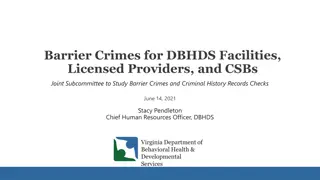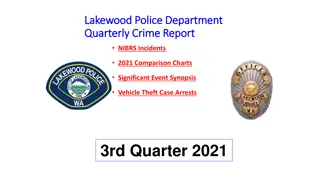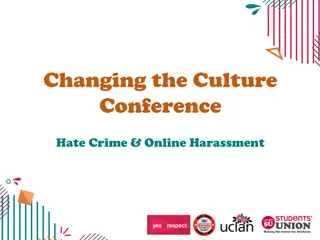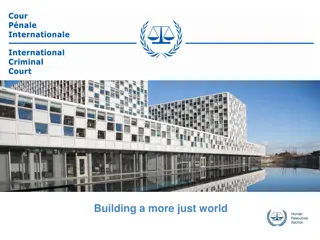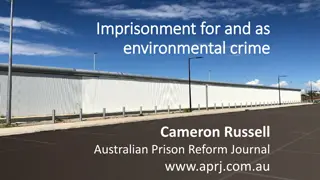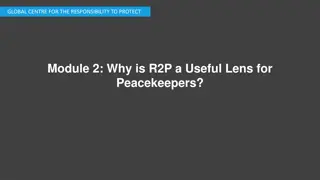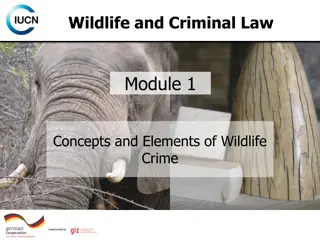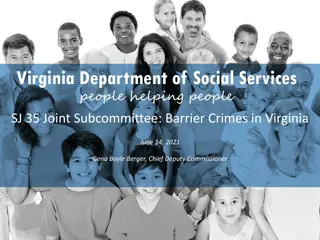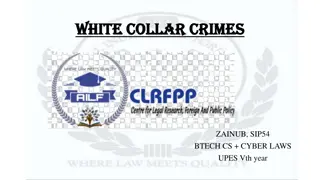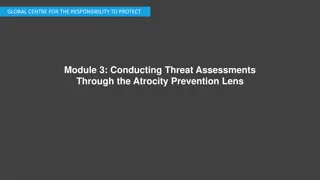R2P in Practice: Responding to Mass Atrocity Crimes
The provided content focuses on the Global Centre for the Responsibility to Protect's module on R2P in action, specifically addressing the response to the threat of mass atrocity crimes. It includes analyses, risk likelihood assessments, and impacts of potential conflicts, emphasizing the need for proactive measures to prevent severe repercussions. The content delves into scenarios, such as the consequences of hate speech in conflict zones, to underscore the importance of early intervention in humanitarian crises.
Download Presentation

Please find below an Image/Link to download the presentation.
The content on the website is provided AS IS for your information and personal use only. It may not be sold, licensed, or shared on other websites without obtaining consent from the author.If you encounter any issues during the download, it is possible that the publisher has removed the file from their server.
You are allowed to download the files provided on this website for personal or commercial use, subject to the condition that they are used lawfully. All files are the property of their respective owners.
The content on the website is provided AS IS for your information and personal use only. It may not be sold, licensed, or shared on other websites without obtaining consent from the author.
E N D
Presentation Transcript
GLOBAL CENTRE FOR THE RESPONSIBILITY TO PROTECT Module 4: R2P in Practice Responding to the Threat of Mass Atrocity Crimes
GLOBAL CENTRE FOR THE RESPONSIBILITY TO PROTECT Phase 2 Analysis Identify Analyze Monitor Treat 1 Module 4: R2P in Practice Responding to the Threat of Mass Atrocity Crimes
GLOBAL CENTRE FOR THE RESPONSIBILITY TO PROTECT Phase 2 Analysis: Articulating the Risk Example (daily life): IF it is raining, THEN I will get wet. Examples (conflict context): IF hate speech continues in South Sudan, THEN targeted killings may increase. IF security forces are not trained in respect for human rights, THEN they may use unnecessary force against civilians and perpetrate arbitrary arrests. 2 Module 4: R2P in Practice Responding to the Threat of Mass Atrocity Crimes
GLOBAL CENTRE FOR THE RESPONSIBILITY TO PROTECT Phase 2 Analysis: Risk Likelihood Risk likelihood: 5. Near certainty 4. Likely 3. Possible 2. Fairly unlikely 1. Remote 3 Module 4: R2P in Practice Responding to the Threat of Mass Atrocity Crimes
GLOBAL CENTRE FOR THE RESPONSIBILITY TO PROTECT Phase 2 Analysis: Risk Likelihood IF IF land for farming and grazing is scare, the rainy season has just ended, and agricultural and herder communities have a history of inter-communal violence, THEN fighting may break out. THEN IF IF fighting breaks out, THEN identity. IF IF fighting breaks out, THEN IF IF fighting breaks out, THEN IF IF fighting breaks out, THEN attacks. THEN civilians may be targeted based upon their religious THEN children may be abducted. THEN villages and property may be intentionally destroyed. THEN a particular group may be massacred in retaliatory 4 Module 4: R2P in Practice Responding to the Threat of Mass Atrocity Crimes
GLOBAL CENTRE FOR THE RESPONSIBILITY TO PROTECT Phase 2 Analysis: Risk Impact Risk impact: 5. Severe unbearable impact 4. High impact 3. Medium impact 2. Moderate impact 1. Bearable impact 5 Module 4: R2P in Practice Responding to the Threat of Mass Atrocity Crimes
GLOBAL CENTRE FOR THE RESPONSIBILITY TO PROTECT Phase 2 Analysis: Scoring the Risk Risk likelihood x Risk impact = Risk score Example: IF hate speech continues in South Sudan, THEN targeted killings may increase. Risk likelihood: 3 x Risk impact: 4 = Risk score: 12 6 Module 4: R2P in Practice Responding to the Threat of Mass Atrocity Crimes
GLOBAL CENTRE FOR THE RESPONSIBILITY TO PROTECT Phase 2 Analysis: Prioritizing R3 R2 R5 R1 R4 7 Module 4: R2P in Practice Responding to the Threat of Mass Atrocity Crimes
GLOBAL CENTRE FOR THE RESPONSIBILITY TO PROTECT MODULE 4 ACTIVITY: CONDUCTING A RISK ASSESSMENT 8 Module 4: R2P in Practice Responding to the Threat of Mass Atrocity Crimes
GLOBAL CENTRE FOR THE RESPONSIBILITY TO PROTECT Phase 3 Treatment Identify Analyze Monitor Treat 9 Module 4: R2P in Practice Responding to the Threat of Mass Atrocity Crimes
GLOBAL CENTRE FOR THE RESPONSIBILITY TO PROTECT Phase 3 Treatment Three options for risk treatment: 1. Transfer (to another actor, entity) 2. Mitigate: consider how to mitigate, the resources needed and key actors involved 3. Accept 10 Module 4: R2P in Practice Responding to the Threat of Mass Atrocity Crimes
GLOBAL CENTRE FOR THE RESPONSIBILITY TO PROTECT Possible options for transfer within mission: Civil Affairs Political Affairs Rule of Law/Judicial Affairs SSR DDR JOC/JMAC Public Information Mission Support DSRSG/RC/HC SRSG s Office Women Protection Advisers Child Protection Advisers Gender Advisers 11 Module 4: R2P in Practice Responding to the Threat of Mass Atrocity Crimes
GLOBAL CENTRE FOR THE RESPONSIBILITY TO PROTECT Possible options for transfer outside the mission: Host State Neighboring States Other UN Actors and Agencies UN Security Council UNHCR OHCHR UNICEF OCHA Regional Organizations Non-State Actors ICRC Local Civil Society 12 Module 4: R2P in Practice Responding to the Threat of Mass Atrocity Crimes
GLOBAL CENTRE FOR THE RESPONSIBILITY TO PROTECT Phase 4 Monitor Identify Analyze Monitor Treat 13 Module 4: R2P in Practice Responding to the Threat of Mass Atrocity Crimes
GLOBAL CENTRE FOR THE RESPONSIBILITY TO PROTECT MODULE 4 ACTIVITY: DEVELOPING TACTICAL RESPONSES TO RISKS 14 Module 4: R2P in Practice Responding to the Threat of Mass Atrocity Crimes
GLOBAL CENTRE FOR THE RESPONSIBILITY TO PROTECT Options for Tactical Response Patrols Conduct joint operations that include military/UNPOL personnel as well as national police/host military forces Evacuation of civilians under threat Conduct cordon and search operations Mobilize quick/rapid reaction forces Neutralize/defeat forces that threaten civilians Support relief for displaced populations Support the provision of humanitarian assistance Civilian asset protection 15 Module 4: R2P in Practice Responding to the Threat of Mass Atrocity Crimes
GLOBAL CENTRE FOR THE RESPONSIBILITY TO PROTECT Addressing the Specific Vulnerabilities of Women and Children Protection and Response Tasks: Tailor patrols to women and children s mobility patterns Ensure that women have access to information and services provided by the mission Support the Protection of Children Support the Elimination of Conflict-Related Sexual Violence Intervene to stop sexual violence from happening when you have early warning information and detain perpetrators whenever possible Establish safe areas for women and children within IDP camps/Protection of Civilian Sites Involve women peacekeeping personnel in cordon and search activities within communities and protection sites Some mission staff are mandated to negotiate action plans on children with armed groups in order to facilitate the return of children and/or deter groups from further recruitment 16 Module 4: R2P in Practice Responding to the Threat of Mass Atrocity Crimes
GLOBAL CENTRE FOR THE RESPONSIBILITY TO PROTECT Consolidation and Preventing Recurrence Disarmament, Demobilization and Reintegration of armed groups Security Sector Reform Inter-communal dialogue and education programs Facilitating the peace process, including supporting the creation of reconciliation programs and transitional justice mechanisms, as well as participation in ceasefire monitoring Quick impact projects Support the restoration and protection of cultural heritage 17 Module 4: R2P in Practice Responding to the Threat of Mass Atrocity Crimes
GLOBAL CENTRE FOR THE RESPONSIBILITY TO PROTECT Module 4 Learning Outcomes - Review By the end of Module 4, learners will: Articulate where R2P and the Atrocity Prevention Lens apply within the day-to-day work of UN peacekeepers Identify, prioritize and formulate a tactical and strategic plan to mitigate risks of atrocity crimes 18 Module 4: R2P in Practice Responding to the Threat of Mass Atrocity Crimes
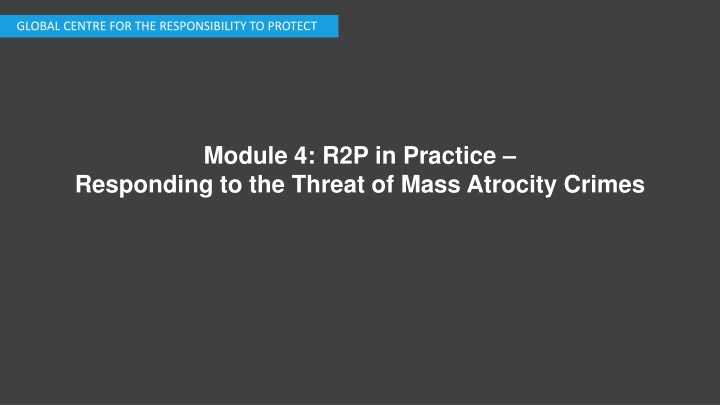

![Prevention and Combating of Hate Crimes and Hate Speech Bill [B.9B.2018]](/thumb/60513/prevention-and-combating-of-hate-crimes-and-hate-speech-bill-b-9b-2018.jpg)






